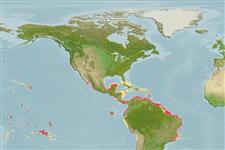Environment: milieu / climate zone / depth range / distribution range
Ecologie
marien rifbewoner; diepte 0 - 50 m (Ref. 9626). Tropical; 25°N - 23°S
Western Atlantic: Panama to Santa Catarina, Brazil (Ref. 57756). Eastern Pacific: Mexico to Peru (Ref. 5530).
Grootte / Gewicht / Leeftijd
Maturity: Lm ? range ? - ? cm
Max length : 30.0 cm TL mannelijk / geslacht onbekend; (Ref. 7251); common length : 20.0 cm TL mannelijk / geslacht onbekend; (Ref. 3798); max. gepubliceerd gewicht: 300.00 g (Ref. 5217)
Dorsale stekels (totaal): 12; Dorsale zachte stralen (totaal): 16; Anale stekels 3; Anale zachte stralen: 9. Body oblong, compressed and not very deep (depth contained 2.5 to 2.9 times in standard length); mouth large and terminal, its posterior end located at the same level as the posterior edge of the pupil; first gill arch with 19 to 25 gill rakers; dorsal fin notched, with 11 to 12 spines and 15 to 17 soft rays (XI-XII, 15-17); second anal spine slightly longer and stronger than third; scale series above lateral line oblique; body dark brown or silver gray; each scale bearing a pearly gray spot, the spots appearing to form lines following the scale series; lower part of preopercle with a black spot; caudal peduncle with a large dark spot; fins grayish (Ref. 55763). Scales below lateral line oblique; anal fin more heavily scaled than other species; silvery gray or brown on back, silvery on sides, with dark lines following oblique scale rows; a large black spot at caudal base (Ref. 13442).
Found over sandy and rubble bottoms; occasionally on coral reefs and rocky areas (Ref. 3798). Rarely in clear oceanic insular areas (Ref. 5217). Often found in schools (Ref. 3798). Juveniles encountered near the shore, over sandy bottoms near seagrass beds (Ref. 9626). Feeds on benthic invertebrates (Ref. 3798). Marketed fresh (Ref. 3798).
Levenscyclus en paargedrag
Maturiteit | Voortplanting | Paaien | Eieren | Fecunditeit | Larven
Oviparous, distinct pairing during breeding (Ref. 205).
McKay, R.J. and M. Schneider, 1995. Haemulidae. Burros, corocoros, chulas, gallinazos, roncos. p. 1136-1173. In W. Fischer, F. Krupp, W. Schneider, C. Sommer, K.E. Carpenter and V. Niem (eds.) Guia FAO para Identification de Especies para lo Fines de la Pesca. Pacifico Centro-Oriental. 3 Vols. FAO, Rome. (Ref. 9114)
Status op de Rode Lijst van het IUCN (Ref. 130435)
Gevaar voor de mens
Harmless
Gebruik door de mens
Visserij: van minder commercieel belang; Aquarium: Publieke aquaria; aas: usually
Meer informatie
ReferentiesAquacultuurAquacultuurprofielKweeklijnenGeneticaElectrophoresesErfelijkheidZiektesVerwerkingNutrientsMassaconversie
Tools
Speciale rapporten
Download XML
Internetbronnen
Estimates based on models
Preferred temperature (Ref.
123201): 23.8 - 28.1, mean 27.1 °C (based on 282 cells).
Fylogenetische diversiteitsindex (Ref.
82804): PD
50 = 0.5000 [Uniqueness, from 0.5 = low to 2.0 = high].
Bayesian length-weight: a=0.01349 (0.00851 - 0.02138), b=3.03 (2.90 - 3.16), in cm total length, based on LWR estimates for this species & Genus-body shape (Ref.
93245).
Trofisch niveau (Ref.
69278): 3.7 ±0.2 se; based on diet studies.
Generation time: 3.7 ( na - na) years. Estimated as median ln(3)/K based on 1
growth studies.
Weerstandsvermogen (Ref.
120179): Gemiddeld, minimale populatieverdubbelingstijd 1,4-4,4 jaar (Preliminary K or Fecundity.).
Fishing Vulnerability (Ref.
59153): Low to moderate vulnerability (34 of 100).
Nutrients (Ref.
124155): Calcium = 46.7 [16.0, 86.1] mg/100g; Iron = 0.58 [0.31, 1.03] mg/100g; Protein = 19.3 [17.4, 21.1] %; Omega3 = 0.145 [0.078, 0.231] g/100g; Selenium = 29.2 [17.4, 47.9] μg/100g; VitaminA = 101 [41, 245] μg/100g; Zinc = 1.2 [0.8, 1.8] mg/100g (wet weight);
